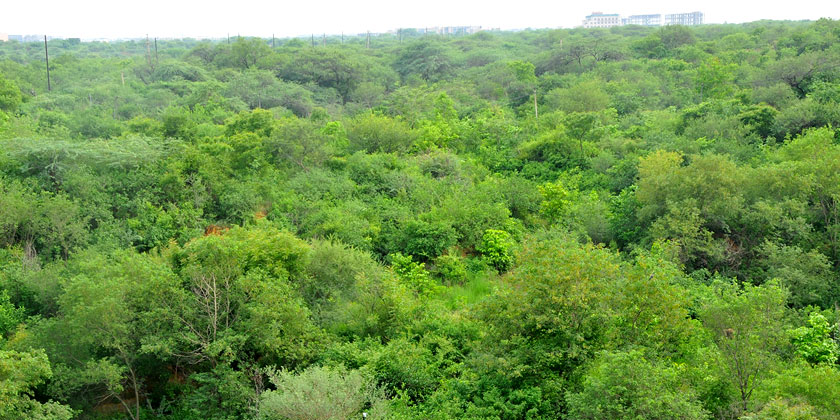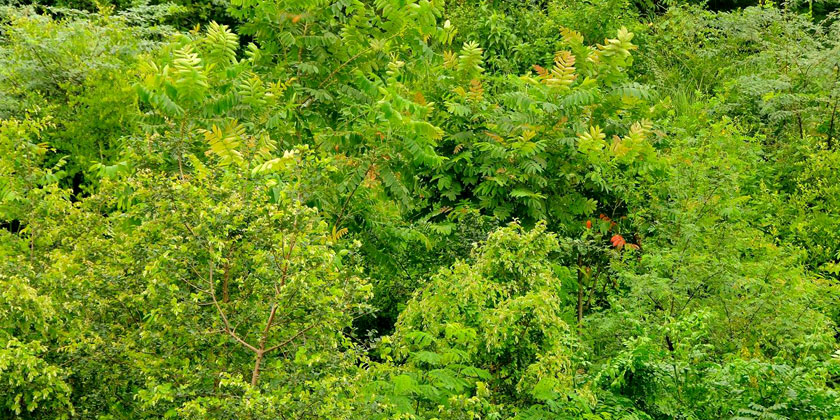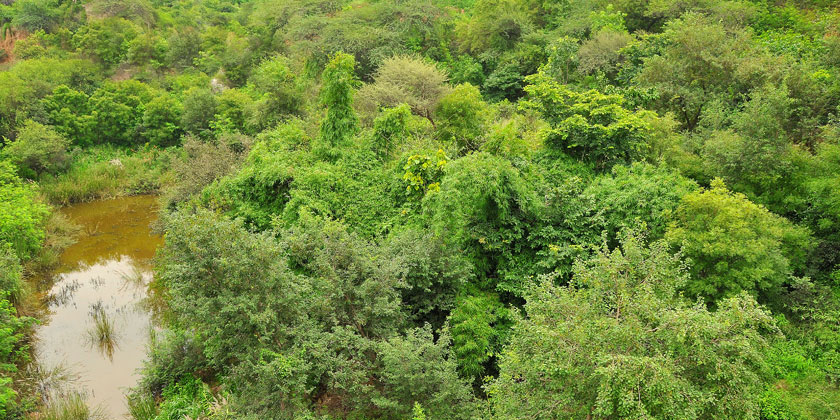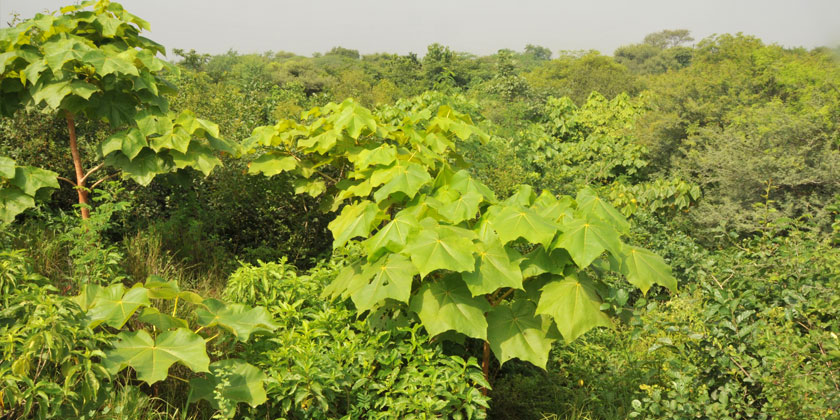Aravalli Biodiversity Park
The Aravalli Biodiversity Park (ABP) is being developed on 699 acres of land located at northwest of Vasant Vihar. The area is highly degraded due to past mining and infested with Prosopis juliflora (Vilayati kikar). The biodiversity of Delhi is nearly extinct. The prime objective of ABP is to bring back the lost biodiversity of Delhi Aravallis. The other objective of ABP is to promote of nature education among students and create environment awareness among the public.
How to reach One can approach to the Aravalli Biodiversity Park, at present, either from Vasant Vihar- Poorvi Marg gate located at about 4 km south west of Moti Bagh, and 2 km west of Jawahar Lal Nehru University (Munirka) or from the Vasant Kunj Institutional gate which is about 3.5 km north of Mahipalpur and one km west of Vasant Kunj Malls.
Structural Components
Visitors' zone
Conservatories
Medicinal garden Overexploitation of medicinal plants from Aravallis has led to local extinction of many species having medicinal value. The ABP is not only preserving but also multiplying the threatened medicinal plants. The medicinal plant conservatory is also used to promote conservation, education and awareness on the importance of plants in health care system.
The Park has more than 240 plant species of medicinal importance. Some notable species are Asthama bel, Brahmi, Gugal, Dardpaat, Rudraksh, Hadjod, Van tulsi, Rakt madar, Nirgundi etc.
Conservatory of Orchids

Orchids are considered as Royal family of plants because of their beautiful flowers, incredible shapes, magnificent colours, fragrance and long lasting nature. Delhi has only one terrestrial orchid species (Zeuxine sulcata) and is nearly extinct.
A small mined pit has been converted into Orchidarium by growing shade trees and climbers. Some important orchids grown in the conservatory are Thunia alba, Vanda cristata, Aerides multiflora, Acampe praemorsa, and Coelogyne cristata. The Orchidarium is used for promoting conservation education among students. More adventures people could walk off to a narrow cave harbouring thousands of bats. Disturbing them by lighting or making noise however, is strictly prohibited.
Conservatory of Ferns

Small mining pits have been developed into fernery on the similar pattern as that of Orchidarium, for the conservation of ferns such as Pteris pellucida, Polystichum sp., Actiniopteris radiata, Marsilea minuta, Pterydium esculentum etc. Ferns are very ancient group of non flowering plants. Orchids and Ferns conservatories are unique and found only in ABP in Delhi.
Conservatory of Butterflies Butterflies and moths render pollination services that make orchards to produce fruits and seeds, crops to produce fruit, vegetables, seeds and grains, and forest plants to produce seeds. To bring back the winged beauties to Delhi, the conservatory of butterfly has been created by planting more than 100 species of host plants of butterflies.
The conservatory has more than 100 species of butterflies and moths. The notable species are Red pierrot, Pansies, Tigers, Grass jewel, Migrants, Common rose, Spot swordtail, Blues, Tiger moths, Skippers, Swifts, etc.
Showcase of Aravalli vegetation A showcase of Aravalli plant communities including Delhi forest, Rajasthan forest and Gujarat forest communities have been developed in visitors' zone. These communities are the miniature of forest communities which are expanded in vast areas of Aravalli Biodiversity Park.
Sacred Grove The area around an old temple has been developed as a sacred grove. All plant species which have religious importance have been planted here such as Ficus, Aegle, Nyctanthes arbor tristis, Sapindus, Madhuca etc.
Tree conservatory A tree conservatory of 10 different native trees of Aravalli ranges has been developed in the visitor’s zone. The tree species are Boswellia serrata, Sterculia uresns, Lannea coromadelica, Prosopis cinereria, Anogeissus serecea, Pterocarpus, Butea monospermaetc.
Nature Reserve zone ABP has a wide range of plant communities ranging from grasslands, shrubland, tropical thorn forest to broad-leaved deciduous forests. About 1000 species native to Aravallis have been ecologically assembled into 35 communities which have become home for many insects, amphibians, birds, reptiles and mammals. Some of the communities are:
(I) Adina – Mitragyna,(ii) Terminalia tomentosa – Holoptelea, (iii)Anogeissus – Butea, (iv) Acacia – Balanites, (v) Wrightia – Holarrhena, (vi)Sterculia – Boswellia, (vii)Grewia – Carissa, (viii)Rhus – Lycium, and (ix) Cenchrus – Heteropogon and others. Many wild fruit yielding shrubs such as Carrissa carandens, Ehretia laevis, Cordia gharaf, Zizyphus sp., Ficus sp. were also planted in association with different forest communities to provide foraging habitat for different animal species.
Rangeland ecosystem The rangeland spreads over an area of 150 acres. The grasslands are interspersed with patches of native bushes bearing edible fruits such as Capparis, Carissa, Zizyphusand Acacia woodland and Butea monosperma - Prosopis cinerariadominant communities. Groups of grey partridges, Indian hares, dancing peacocks, Black-breasted weavers, Indian silver-bills and occasionally thirsty jackals and blue bull are common inside the rangelands.
Nature Education Aravalli Biodiversity Park with its unique and beautiful undulating landscape harbouring Aravalli's natural heritage, is a paradise for nature lovers. The Park has network of nature trails passing through the dense recreated forest communities, grasslands and seasonal water bodies. Nature Education at Aravalli Biodiversity Park involves activities to inculcate love for Nature and its Conservation among people, especially the younger generation. Many programmes are conducted to spread the message of nature conservation focusing biodiversity and its benefits if you have around. The primary thrust of all the activities are learning by doing. Park encourages all nature lovers and all those who are interested in observing and learning from nature. This effort is an attempt “How to learn from Nature”. The Aravalli Biodiversity Park is the only place in Delhi which provides unique camping facilities to school children for imparting environmental education in natural ambience. A number of schools and colleges of NCT of Delhi have been availing this facility since the inception of this park. Scientists and nature education staff of the park interact with students and expose their first contact with nature, which can start a lifelong interest. It is a hub for conservation education.




